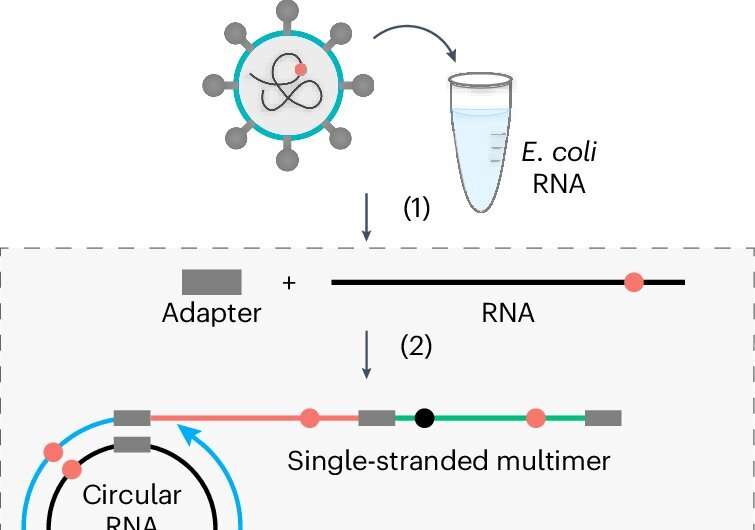This article has been reviewed according to Science X's editorial process and policies. Editors have highlighted the following attributes while ensuring the content's credibility:
fact-checked
peer-reviewed publication
trusted source
proofread
New technology uncovers mechanism affecting generation of new COVID variants

The SARS-CoV-2 virus that causes COVID has the unsettling ability of often generating variants of itself. Other viruses also mutate, but as SARS-CoV-2 quickly spread throughout the entire human population during the pandemic, killing millions, the virus' dynamic evolution posed a serious problem: it repeatedly challenged our bodies' immune response and hindered the process of getting updated vaccines ready.
Understanding the genetic mechanism fueling SARS-CoV-2's ability to generate variants can go a long way in keeping COVID at bay. In a study published in Nature Microbiology, researchers at Baylor College of Medicine and collaborating institutions developed a new technology called tARC-seq that revealed a genetic mechanism affecting SARS-CoV-2 divergence and enabled the team to calculate SARS-CoV-2's mutation rate.
Using tARC-seq, the researchers also captured new mutations in SARS-CoV-2 in infected cells in the lab that recapitulated observations revealed by worldwide pandemic viral sequencing data. The findings can be useful for monitoring viral evolution in the human population.
"The SARS-CoV-2 virus uses RNA, instead of DNA, to store its genetic information. Our lab has long been interested in studying RNA biology, and when SARS-CoV-2 emerged we decided to investigate its process of RNA replication, which is typically error prone in RNA viruses," said corresponding author Dr. Christophe Herman, professor of molecular and human genetics and of molecular virology and microbiology at Baylor.
The researchers wanted to follow RNA replication errors because they are crucial for understanding how the virus evolves, how it changes and adapts as it spreads in the human population, but current methods lacked the precision to detect rare new SARS-CoV-2 mutations, particularly in samples with a low number of viruses, such as those from patients.
"Because samples from patients have very few SARS-CoV-2 RNA copies, it is difficult to distinguish between the errors made by SARS-CoV-2 RNA-dependent RNA polymerase (RdRp), the enzyme that makes copies this virus' RNA, and the errors from the other enzymes used in the sequence analysis," said Herman, a member of the Dan L Duncan Comprehensive Cancer Center.
"We have developed a technique that we call Targeted Accurate RNA Consensus sequencing (tARC-seq), which allows us to measure true errors when copying specific RNA present in very low amounts."
A new perspective on the drivers of SARS-CoV-2 variant diversity
Originally, the thought was that, because SARS-CoV-2 has an internal mechanism to repair the mistakes RdRp makes, then the virus should not evolve or mutate very quickly.
"This idea contrasted with the fact that during the pandemic new COVID variants emerged often around the world," Herman said. "Since the pandemic began, we've seen a number of prominent variants, including alpha, beta, delta and omicron, as well as variants within these groups."
With their improved analytical tool in hand, Herman and his colleagues accurately determined the mutation frequency of SARS-CoV-2 and types of mutations, both in cell cultures in the lab and clinical samples. "We found that the mutation rate was higher than originally expected and this helps explain the frequent appearance of COVID variants," Herman said.
They also discovered that there are hotspots in SARS-CoV-2 RNA, locations that are more prone to mutation than others. "For example, we identified a hotspot on the RNA region corresponding to the spike protein, the protein that allows the virus to invade cells. Also, RNA of the spike protein makes up many vaccines," Herman said.
The tARC-seq method also revealed that the generation of new variants involved template switching. "We determined that, as RdRp is copying one RNA template or sequence, it jumps to another template on a nearby virus and then continues copying the RNA, so the resulting new RNA copy is a mixture of both RNA templates," Herman said.
"This template switching will result in sequence insertions or deletions that bring about viral variability. We also observed complex mutations. SARS-CoV-2 takes advantage of these two powerful biological mechanisms, template switching and complex mutations, that allow it to evolve quickly, generating variants to adapt to and persevere in human populations."
"It was interesting and exciting to see that tARC-seq allowed us to capture in laboratory cell cultures the emergence of new mutations that recapitulate the mutations observed with worldwide pandemic sequencing data," Herman said.
"Our new technology captures a snapshot of new mutations in clinical samples from individual patients and can be useful for monitoring viral evolution in the human population."
More information: Targeted Accurate RNA Consensus sequencing (tARC-seq) reveals mechanisms of replication error affecting SARS-CoV-2 divergence, Nature Microbiology (2024). DOI: 10.1038/s41564-024-01655-4




















